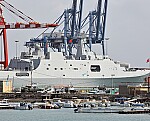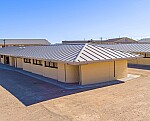North Korea sends ballistic missiles to Russia in growing strategic alliance, U.S. Admiral warns
The United States is expressing growing concern over a deepening military partnership between North Korea and Russia, as new intelligence reveals that Pyongyang has supplied Moscow with a significant quantity of artillery shells and ballistic missiles to support its war in Ukraine. In exchange, North Korea is reportedly receiving advanced Russian air defense systems—an alarming development with far-reaching implications for regional and global security.
Admiral Samuel Paparo, the new commander of U.S. Indo-Pacific Command (INDOPACOM), testified this week before the Senate Armed Services Committee, offering the most detailed public account to date of the ongoing weapons trade between two of America’s most prominent adversaries.
“It’s a transactional symbiosis where each state fulfills the other state’s weakness to mutual benefit of each state,” Paparo told lawmakers, characterizing the military exchange as a marriage of convenience that strengthens both regimes while undermining international stability.
Missiles for Missile Defense
According to Admiral Paparo, North Korea has shipped hundreds of short-range ballistic missiles and potentially hundreds of thousands of artillery shells to Russia. These weapons are being used to replenish Russia’s depleting munitions stockpiles amid its prolonged and grinding war in Ukraine, particularly in the contested eastern regions where artillery fire remains a dominant form of combat.
In return, North Korea is expected to receive surface-to-air missile systems, and potentially other advanced components, to bolster its own aging and limited air defense network. The precise types of systems have not been disclosed, but analysts suggest that even second-tier Russian systems could dramatically improve North Korea’s ability to deter aerial surveillance and potential air strikes.
This arms-for-technology arrangement has alarmed both U.S. and South Korean officials, who fear that such transfers could accelerate North Korea’s efforts to modernize its military and further embolden its aggressive posture in East Asia.

Mounting Evidence and Escalating Coordination
Evidence of this growing military exchange has been accumulating for several months. In December 2024, open-source intelligence analysts spotted a Russian train convoy carrying what appeared to be missile launchers similar to North Korea’s Pukguksong-2 (KN-15)—a solid-fueled, road-mobile, medium-range ballistic missile that has been central to North Korea’s recent military parades and test launches. Though the imagery was of poor quality, the shape and configuration were consistent with known North Korean designs.
South Korean media reported in February 2025 that another arms shipment was scheduled for delivery before the end of March. These shipments reportedly included KN-23 short-range ballistic missiles—North Korea’s modern equivalent to Russia’s Iskander—as well as 122mm and 152mm artillery shells compatible with Soviet-era systems still used by Russian forces.
While the United States has previously acknowledged a flow of North Korean weapons to Russia, Admiral Paparo’s testimony marks one of the most explicit confirmations from a high-level military authority, underscoring growing alarm within the Pentagon about the scale and impact of this partnership.
Strategic Consequences for the Indo-Pacific
The implications of this military collaboration stretch well beyond Ukraine. For U.S. allies such as South Korea and Japan, a North Korea equipped with modern Russian air defense systems could pose a more resilient and defiant threat—less vulnerable to preemptive strikes and more capable of surviving a prolonged conflict.
This also complicates the calculus for the United States and its regional partners as they seek to maintain deterrence on the Korean Peninsula. A more militarily capable North Korea could become bolder in its provocations, increasing the risk of miscalculation or conflict escalation.
Moreover, the exchange underlines how sanctions regimes—aimed at isolating both Russia and North Korea—are being openly flouted, eroding the effectiveness of international enforcement mechanisms.
“This is more than just an arms deal,” said one senior U.S. defense official speaking off the record. “This is a strategic alignment between two authoritarian regimes that are pushing back against a Western-led order. We are seeing a dangerous convergence of interests.”
A New Axis of Autocracy?
The strengthening ties between Pyongyang and Moscow reflect a wider realignment in global geopolitics, as authoritarian regimes increasingly look to one another for support amid rising tensions with the West. As China continues to provide economic and diplomatic cover for Russia, and Iran reportedly supplies drones and munitions, North Korea is now emerging as a critical supplier of battlefield hardware in exchange for cutting-edge technology.
This growing “axis of autocracy” is especially worrisome for U.S. strategists, who fear that these transactions could eventually include nuclear delivery systems, satellite technology, or cyber capabilities.
While the U.S. and its allies continue to supply Ukraine and reinforce defense ties in the Indo-Pacific, the dual-front challenge from Russia and North Korea is testing the limits of international coordination.
Looking Ahead
In the coming months, observers will be watching for further signs of technological transfer, weapons testing, or diplomatic visits between Russian and North Korean officials. The U.S. may also consider new rounds of sanctions or military countermeasures to disrupt the supply chain between the two regimes.
For now, Admiral Paparo’s warning serves as a stark reminder that the war in Ukraine is not confined to Europe—and that its consequences are reverberating across continents, reshaping alliances, and redrawing lines of confrontation in the 21st century.









